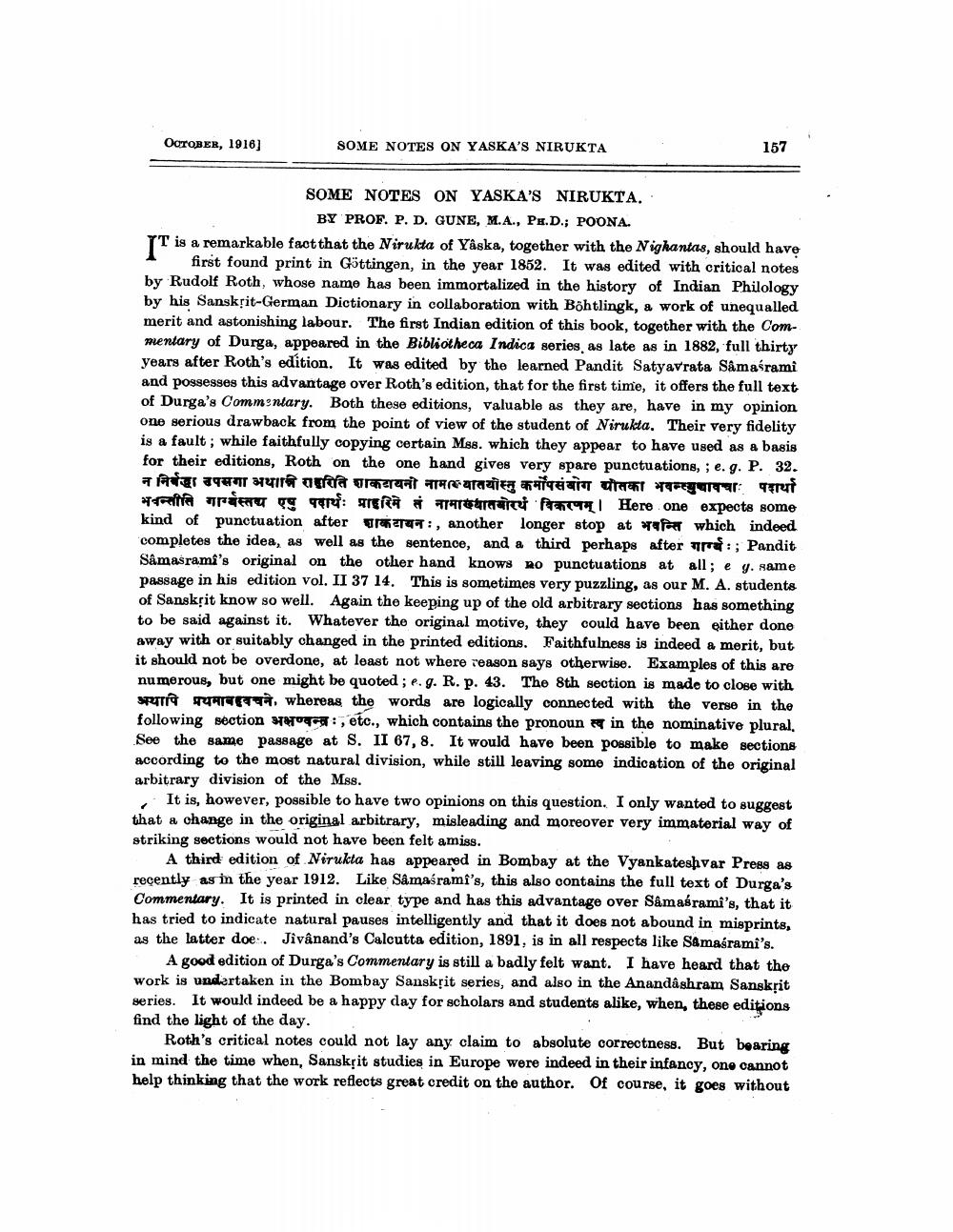________________
OCTOBER, 1916]
SOME NOTES ON YASKA'S NIRUKTA
157
SOME NOTES ON YASKA'S NIRUKTA. BY PROF. P. D. GUNE, M.A., PH.D.; POONA.
IT
is a remarkable fact that the Nirukta of Yâska, together with the Nighantas, should have first found print in Göttingen, in the year 1852. It was edited with critical notes by Rudolf Roth, whose name has been immortalized in the history of Indian Philology by his Sanskrit-German Dictionary in collaboration with Böhtlingk, a work of unequalled merit and astonishing labour. The first Indian edition of this book, together with the Commentary of Durga, appeared in the Bibliotheca Indica series, as late as in 1882, full thirty years after Roth's edition. It was edited by the learned Pandit Satyavrata Sâmaśrami and possesses this advantage over Roth's edition, that for the first time, it offers the full text of Durga's Commentary. Both these editions, valuable as they are, have in my opinion one serious drawback from the point of view of the student of Nirukta. Their very fidelity is a fault; while faithfully copying certain Mss. which they appear to have used as a basis for their editions, Roth on the one hand gives very spare punctuations,; e. g. P. 32. न निर्बद्धा उपसगा भथानि राहुरिति शाकटायनो नाम स्यातयोस्तु कर्मोपसंयोग द्योतका भवन्त्युचावचा पदार्था भवन्तीति गार्ग्यस्तद्य एषु पदार्थः प्राहरिमे तं नामाख्यातबोरथं विकरणम् | Here one expects some kind of punctuation after :, another longer stop at war which indeed completes the idea, as well as the sentence, and a third perhaps after ; Pandit Sâmasrami's original on the other hand knows no punctuations at all; e y. same passage in his edition vol. II 37 14. This is sometimes very puzzling, as our M. A. students of Sanskrit know so well. Again the keeping up of the old arbitrary sections has something to be said against it. Whatever the original motive, they could have been either done away with or suitably changed in the printed editions. Faithfulness is indeed a merit, but it should not be overdone, at least not where reason says otherwise. Examples of this are numerous, but one might be quoted; e. g. R. p. 43. The 8th section is made to close with अथापि प्रथमाबहवचने, whereas the words are logically connected with the verse in the following section arc, etc., which contains the pronoun in the nominative plural, See the same passage at S. II 67, 8. It would have been possible to make sections according to the most natural division, while still leaving some indication of the original arbitrary division of the Mss.
It is, however, possible to have two opinions on this question. I only wanted to suggest that a change in the original arbitrary, misleading and moreover very immaterial way of striking sections would not have been felt amiss.
A third edition of Nirukta has appeared in Bombay at the Vyankateshvar Press as recently as in the year 1912. Like Sâmasrami's, this also contains the full text of Durga's Commentary. It is printed in clear type and has this advantage over Sâmaérami's, that it has tried to indicate natural pauses intelligently and that it does not abound in misprints, as the latter doe. Jivânand's Calcutta edition, 1891, is in all respects like Samasramî's.
A good edition of Durga's Commentary is still a badly felt want. I have heard that the work is undertaken in the Bombay Sanskrit series, and also in the Anandâshram Sanskrit series. It would indeed be a happy day for scholars and students alike, when, these editions find the light of the day.
Roth's critical notes could not lay any claim to absolute correctness. But bearing in mind the time when, Sanskrit studies in Europe were indeed in their infancy, one cannot help thinking that the work reflects great credit on the author. Of course, it goes without




